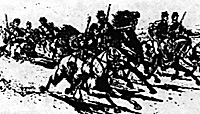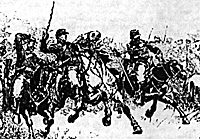 Prompted by the cheap purchase of the John Wayne classic HORSE SOLDIERS on video, I thought this would make a good scenario. My enthusiasm was not dampened by the fact it was typically shown on TV a few days later! The film is based on Col. Benjamin H Grierson's raid into Mississippi in April 1863. John Wayne played a Col. Marlow leading 3 regiments of Union cavalry to destroy the railroad at Newton Station.
Prompted by the cheap purchase of the John Wayne classic HORSE SOLDIERS on video, I thought this would make a good scenario. My enthusiasm was not dampened by the fact it was typically shown on TV a few days later! The film is based on Col. Benjamin H Grierson's raid into Mississippi in April 1863. John Wayne played a Col. Marlow leading 3 regiments of Union cavalry to destroy the railroad at Newton Station.
In November 1862 Grant began the campaign to capture Vicksburg, Mississippi. The siege of the city did not start until June of the next year. A series of battles were fought and raids were mounted, including Grierson's to isolate its defenders.
Grierson had at his disposal 6th & 7th Illinois and the 2nd Iowa under Col. E Hatch, plus Battery 'K' 1st Illinois Light Artillery. In total the force amounted to around 1,700 men. Setting off from La Grange Tennessee on 17 April with orders to cause as much damage as possible, to transport and supply lines in the very heart of the Confederacy. This in turn would put extra pressure on the defenders of Vicksburg. The main focus of the expedition was, as in the film, Newton Station.
Before reaching Newton Station several small actions were fought, Grierson wanted to avoid a fight but a major engagement at Columbus saw Col Hatch seriously wounded and the 2nd Iowa badly mauled. The destruction of Newton Station caused widespread alarm. An army of unknown size was on the rampage. A report in a Mississippi newspaper read "Where they will turn up next or what damage they will do, heaven only knows"
From Newton Station Grierson headed for Union held Baton Rouge in Louisiana. All the time harassed and pursued by Confederate troops, fighting rearguard actions and finally forcing a passage over the Tichfaw River arriving at Baton Rouge on 1st May. For the loss of minimal casualties, miles of railroad and other facilities had been destroyed, nearly a 1,000 horses and mules captured; and reported to have tied up some 38,000 Confederates. Sherman called it "The most brilliant raid of the war."
The Wargame
The rules I used were FIRE & FURY. These are brigade size but can be used for a regimental size game. I also had the benefits of my local club, North London Wargames Group, in the use of four 4ft by 6ft tables laid end to end thus giving a 24ft x 4ft playing surface. The entry point for the Union troops at one end with Newton Station at the other. A series of roads were placed, I used masking tape for this, plus the large areas of woods, streams, rivers, small hills and a couple of small towns to taste.
A team of umpires, two at least; one or two Union players and a similar number for the Confederates are all the personnel needed, as the amount of figures required is relatively small. If space is at a premium a map style campaign could be done, transferring the action onto the table top when forces meet. The Union passage to Newton Station was dogged by Confederate patrols. To simulate this I drew a map 24" x 6" with a grid of 96 squares, numbered from 1 - 96. I gave the Confederates 5 patrols using 2 x D10`s, to give the position of these single stand units, a score of 97-100 means that patrol is off table. The stand is placed in the centre of the square. In the confederate move phase one of the umpires rolls 2 x D10 for each patrol to determine its direction and move of 12" only. A score of 1-12 indicates that it moves in the direction nominated as north. 13-24 north east, 25-36 east and so on. A score of 97-100 they are stationary that move. If it moves off table it does not come back. If in the umpires` opinion the patrol spots the Union troops the stand is placed on the table. here the game takes over and normal moves apply.
There should he several exit points for the patrol nominated on the map, if it makes it the local garrison has been roused. These garrison troops will then move toward the position last reported and can be handled on the map by the umpire. From here the umpire will furnish the Confederate player with such information as he deems fit and dice are thrown for the possible direction they will take.
The size of these units can be at the umpire's discretion, or a chance card system can be used. i.e. a pack of playing cards, 2-7 2 units both infantry, 8-10 3 units 1 cavalry, 2 infantry, JQK 4 units 1 or 2 cavalry, 2 or 3 infantry, ACE 4 units plus an artillery battery, all have 1 leader, on an ACE he will be an E (exceptional). Troops in towns should only be one unit of poor quality, i.e. -/4/3.
FILM BUFFS BIT
 An optional rule, for those who have seen the film is "Thar`s a train coming colonel, sur." A train pulls into Newton Station and disgorges a regiment of Confederate infantry, who can be good quality but disordered. This would be declared, subject to a die roll during the previous Confederate move phase. Another would be false information given by local plantation owners, such as Miss Hunter of Greenbrier. The Union player can destroy bridges, I company engaged in no other action for 2 movement phases can do this.
An optional rule, for those who have seen the film is "Thar`s a train coming colonel, sur." A train pulls into Newton Station and disgorges a regiment of Confederate infantry, who can be good quality but disordered. This would be declared, subject to a die roll during the previous Confederate move phase. Another would be false information given by local plantation owners, such as Miss Hunter of Greenbrier. The Union player can destroy bridges, I company engaged in no other action for 2 movement phases can do this.
However Confederate patrols can hear what went on if they are in the same or adjacent "square" and will move toward it in their turn. Also watch out for the one armed Col. J Miles in the telegraph office, who else did he contact? If the Union player is advised by the Umpire that a Confederate force of some size has been spotted bv his scouts (Grierson had some of his men pose as Confederates) an option would be to detach a few companies to lead them away from the main body, as in the film, Col. C Cord and 1st michigan and in life with Col. Hatch and the 2nd Iowa. Grierson had a battery of artillery with him.
Union troops had control of Newton Station for a reasonable time, to destroy rolling stock, track etc. Here the game can end or continue with the Union retreat to Baton Rouge. Using modified terrain, add a swamp etc. double the Confederate patrols. The game ending with Union troops crossing the Tickfaw River.
WINNERS & LOSERS
Victory points are gained as per the rules, with 10 extra for the desttuction of Newton Station. The Confederates are given 10 if no Union troops cross the Tickfaw. The Confederates gain a bonus of 4 if Grierson is killed.
UNIT SIZES
The Union cavalry regiments can have the the option to be split into 2 stand companies and classed as being Crack i.e. 2-/-, otherwise the 6th lllinois are 12/8/5, the 7th Illinois 10/7/4, 2nd Iowa 6/5/3. All Union command fignires are classed as exceptional. Most Confederate troops are classed as second rate, as mentioned, town troops -/4/3, train riders 8/5/3 disordered 'Garrison Infantry' 6/5/4 and 8/7/5, cavalry are classed as veteran so can be 6/5/3. The high numbers for the Union are used to compensate for the natural attrition that will happen. If any Union troops become spent they have the option to join others and their ratings adjusted accordingly. This is to represeut the adverse effects of being in hostile territory, causing troops to join together for mutual support. Union stands that "skedaddle' have a 50% chance of a die roll to rejoin their units` next movement phase.
It's important to note that it`s the umpires job to keep things interesting, fast moving and most of all enjoyable for everyone involved. If he belongs to the make it up as you go along school, so much the better.
Back to The Gauntlet No. 9 Table of Contents
Back to The Gauntlet List of Issues
Back to Master Magazine List
© Copyright 1997 by Craig Martelle Publications
This article appears in MagWeb (Magazine Web) on the Internet World Wide Web.
Other military history articles and gaming articles are available at http://www.magweb.com